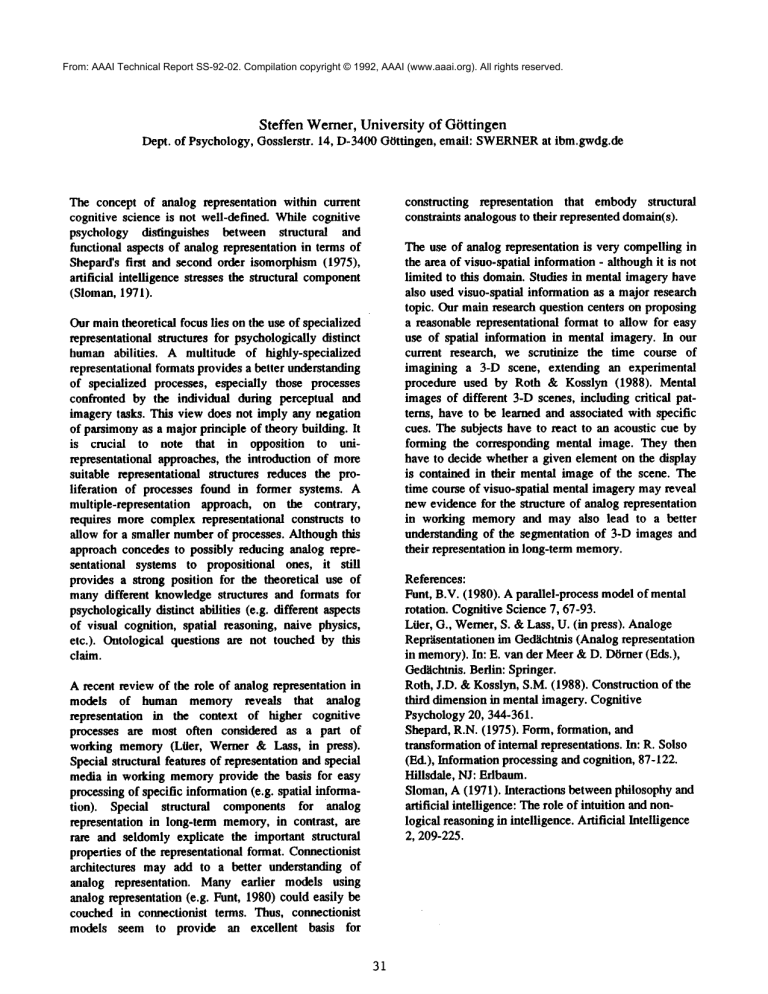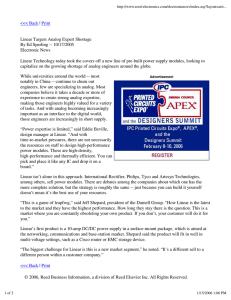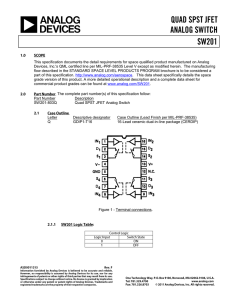
From: AAAI Technical Report SS-92-02. Compilation copyright © 1992, AAAI (www.aaai.org). All rights reserved.
Steffen Wemer,University of GiSttingen
Dept. of Psychology, Gosslerstr. 14, D-3400O0ttingen, email: SWERNER
at ibm.gwdg.de
The concept of analog representation within current
cognitive science is not well-defined. Whilecognitive
psychology distinguishes between structural and
functional aspects of analog representation in terms of
Shepard’s first and second order isomorphism(1975),
artificial intelligence stresses the structural component
(Sloman,1971).
Ourmaintheoretical focuslies on the use of specialized
representationalstructures for psychologicallydistinct
humanabilities. A multitude of highly-specialized
representational formatsprovidesa better understanding
of specialized processes, especially those processes
confronted by the individual during perceptual and
imagerytasks. This view does not implyany negation
of parsimonyas a majorprinciple of theory building. It
is crucial to note that in opposition to unirepresentational approaches,the introduction of more
suitable representational structures reduces the proliferation of processes found in former systems. A
multiple-representation approach, on the contrary,
requires more complexrepresentational constructs to
allow for a smaller numberof processes. Althoughthis
approachconcedesto possibly reducing analog representational systems to propositional ones, it still
provides a strong position for the theoretical use of
manydifferent knowledgestructures and formats for
psychologically
distinct abilities (e.g. different aspects
of visual cognition, spatial reasoning, naive physics,
etc.). Ontological questions are not touchedby this
claim.
A recent reviewof the role of analogrepresentation in
models of human memory reveals that analog
representation in the context of higher cognitive
processes are most often considered as a part of
working memory(LUer, Werner & Lass, in press).
Special structural features of representationandspecial
media in working memoryprovide the basis for easy
processingof specific information(e.g. spatial information). Special structural components for analog
representation in long-term memory,in contrast, are
rare and seldomlyexplicate the important structural
properties of the representationalformat. Connectionist
architectures mayadd to a better understanding of
analog representation. Manyearlier models using
analogrepresentation (e.g. Funt, 1980) could easily
couched in connectionist terms. Thus, connectionist
models seem to provide an excellent basis for
31
constructing representation that embodystructural
constraints analogousto their representeddomain(s).
Theuse of analog representation is very compellingin
the area of visuo-spatialinformation- althoughit is not
limited to this domain.Studies in mentalimageryhave
also used visuo-spatial informationas a major research
topic. OUrmainresearch question centers on proposing
a reasonablerepresentational format to allow for easy
use of spatial information in mental imagery. In our
current research, we scrutinize the time course of
imagining a 3-D scene, extending an experimental
procedure used by Roth & Kosslyn (1988). Mental
imagesof different 3-Dscenes, including critical patterns, have to be learned and associated with specific
cues. Thesubjects have to react to an acoustic cue by
forming the corresponding mental image. They then
have to decide whethera given elementon the display
is contained in their mental imageof the scene. The
time course of visuo-spatial mentalimagerymayreveal
newevidencefor the structure of analogrepresentation
in working memoryand may also lead to a better
understanding of the segmentation of 3-D images and
their representation in long-termmemory.
References:
Funt, B.V.(1980). Aparallel-process modelof mental
rotation. CognitiveScience7, 67-93.
L0er, G., Werner,S. &Lass, U. (in press). Analoge
Repr~isentationenim Gedtichtnis(Analogrepresentation
in memory).In: E. van der Meet& D. l~mer(Eds.),
Oeditchtnis.Berlin: Springer.
Roth, LD.& Kosslyn,S.M. (1988). Constructionof the
third dimensionin mentalimagery.Cognitive
Psychology20, 344-361.
Shepard,R.N. (1975). Form,formation, and
transformationof intemalrepresentations. In: R. Solso
(Ed.), Informationprocessingand cognition, 87-122.
Hillsdale, NJ: Erlbaum.
Sloman,A (1971). Interactions betweenphilosophyand
artificial intelligence: Therole of intuition andnonlogical reasoningin intelligence. Artificial Intelligence
2, 209-225.



